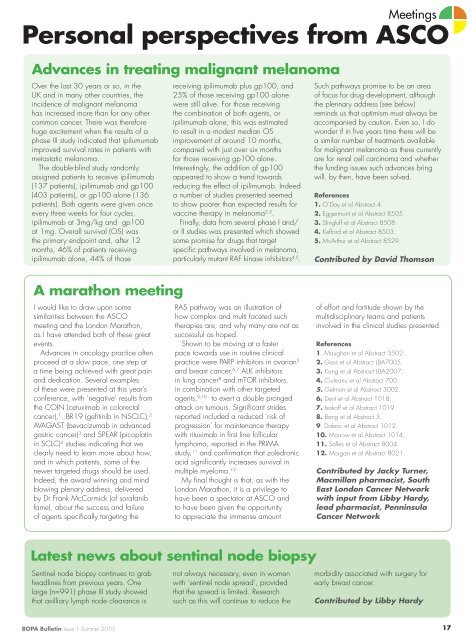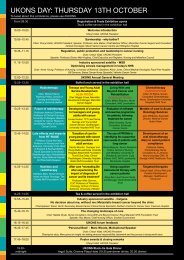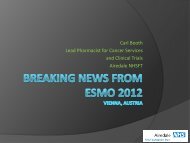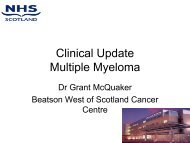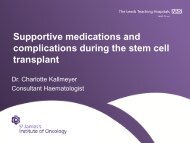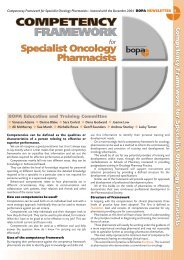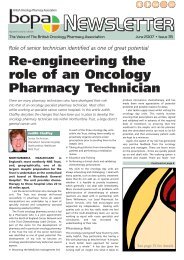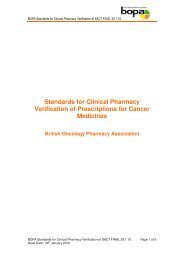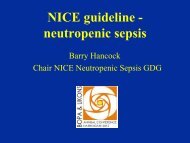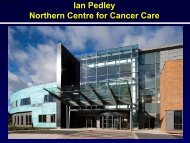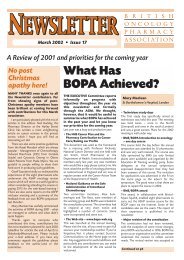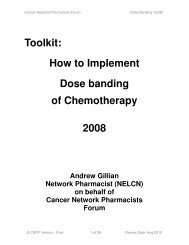What might the current Westminster Government mean for ... - BOPA
What might the current Westminster Government mean for ... - BOPA
What might the current Westminster Government mean for ... - BOPA
You also want an ePaper? Increase the reach of your titles
YUMPU automatically turns print PDFs into web optimized ePapers that Google loves.
Meetings<br />
Personal perspectives from ASCO<br />
Advances in treating malignant melanoma<br />
Over <strong>the</strong> last 30 years or so, in <strong>the</strong><br />
UK and in many o<strong>the</strong>r countries, <strong>the</strong><br />
incidence of malignant melanoma<br />
has increased more than <strong>for</strong> any o<strong>the</strong>r<br />
common cancer. There was <strong>the</strong>re<strong>for</strong>e<br />
huge excitement when <strong>the</strong> results of a<br />
phase III study indicated that ipilumumab<br />
improved survival rates in patients with<br />
metastatic melanoma.<br />
The double-blind study randomly<br />
assigned patients to receive ipilimumab<br />
(137 patients), ipilimumab and gp100<br />
(403 patients), or gp100 alone (136<br />
patients). Both agents were given once<br />
every three weeks <strong>for</strong> four cycles,<br />
ipilimumab at 3mg/kg and gp100<br />
at 1mg. Overall survival (OS) was<br />
<strong>the</strong> primary endpoint and, after 12<br />
months, 46% of patients receiving<br />
ipilimumab alone, 44% of those<br />
receiving ipilimumab plus gp100, and<br />
25% of those receiving gp100 alone<br />
were still alive. For those receiving<br />
<strong>the</strong> combination of both agents, or<br />
ipilimumab alone, this was estimated<br />
to result in a modest median OS<br />
improvement of around 10 months,<br />
compared with just over six months<br />
<strong>for</strong> those receiving gp100 alone.<br />
Interestingly, <strong>the</strong> addition of gp100<br />
appeared to show a trend towards<br />
reducing <strong>the</strong> effect of ipilimumab. Indeed<br />
a number of studies presented seemed<br />
to show poorer than expected results <strong>for</strong><br />
vaccine <strong>the</strong>rapy in melanoma 2,3 .<br />
Finally, data from several phase I and/<br />
or II studies was presented which showed<br />
some promise <strong>for</strong> drugs that target<br />
specific pathways involved in melanoma,<br />
particularly mutant RAF kinase inhibitors 4,5 .<br />
Such pathways promise to be an area<br />
of focus <strong>for</strong> drug development, although<br />
<strong>the</strong> plennary address (see below)<br />
reminds us that optimism must always be<br />
accompanied by caution. Even so, I do<br />
wonder if in five years time <strong>the</strong>re will be<br />
a similar number of treatments available<br />
<strong>for</strong> malignant melanoma as <strong>the</strong>re <strong>current</strong>ly<br />
are <strong>for</strong> renal cell carcinoma and whe<strong>the</strong>r<br />
<strong>the</strong> funding issues such advances bring<br />
will, by <strong>the</strong>n, have been solved.<br />
References<br />
1. O’Day et al Abstract 4.<br />
2. Eggermont et al Abstract 8505.<br />
3. Slingluff et al Abstract 8508.<br />
4. Kef<strong>for</strong>d et al Abstract 8503.<br />
5. McArthur et al Abstract 8529.<br />
Contributed by David Thomson<br />
A marathon meeting<br />
I would like to draw upon some<br />
similarities between <strong>the</strong> ASCO<br />
meeting and <strong>the</strong> London Marathon,<br />
as I have attended both of <strong>the</strong>se great<br />
events.<br />
Advances in oncology practice often<br />
proceed at a slow pace, one step at<br />
a time being achieved with great pain<br />
and dedication. Several examples<br />
of <strong>the</strong>se were presented at this year’s<br />
conference, with ‘negative’ results from<br />
<strong>the</strong> COIN (cetuximab in colorectal<br />
cancer), 1 BR19 (gefitinib in NSCLC), 2<br />
AVAGAST (bevacizumab in advanced<br />
gastric cancer) 3 and SPEAR (picoplatin<br />
in SCLC) 4 studies indicating that we<br />
clearly need to learn more about how,<br />
and in which patients, some of <strong>the</strong><br />
newer targeted drugs should be used.<br />
Indeed, <strong>the</strong> award winning and mind<br />
blowing plenary address, delivered<br />
by Dr Frank McCormick (of sorafanib<br />
fame), about <strong>the</strong> success and failure<br />
of agents specifically targeting <strong>the</strong><br />
RAS pathway was an illustration of<br />
how complex and multi faceted such<br />
<strong>the</strong>rapies are, and why many are not as<br />
successful as hoped.<br />
Shown to be moving at a faster<br />
pace towards use in routine clinical<br />
practice were PARP inhibitors in ovarian 5<br />
and breast cancer, 6,7 ALK inhibitors<br />
in lung cancer 8 and mTOR inhibitors,<br />
in combination with o<strong>the</strong>r targeted<br />
agents, 9,10 to exert a double pronged<br />
attack on tumours. Significant strides<br />
reported included a reduced ‘risk of<br />
progression’ <strong>for</strong> maintenance <strong>the</strong>rapy<br />
with rituximab in first line follicular<br />
lymphoma, reported in <strong>the</strong> PRIMA<br />
study, 11 and confirmation that zoledronic<br />
acid significantly increases survival in<br />
multiple myeloma. 12<br />
My final thought is that, as with <strong>the</strong><br />
London Marathon, it is a privilege to<br />
have been a spectator at ASCO and<br />
to have been given <strong>the</strong> opportunity<br />
to appreciate <strong>the</strong> immense amount<br />
of ef<strong>for</strong>t and <strong>for</strong>titude shown by <strong>the</strong><br />
multidisciplinary teams and patients<br />
involved in <strong>the</strong> clinical studies presented.<br />
References<br />
1. Maughan et al Abstract 3502.<br />
2. Goss et al Abstract LBA7005.<br />
3. Kang et al Abstract LBA2007.<br />
4. Ciuleanu et al Abstract 700.<br />
5. Gelmon et al Abstract 3002.<br />
6. Dent et al Abstract 1018.<br />
7. Isakoff et al Abstract 1019.<br />
8. Bang et al Abstract 3.<br />
9. Dalenc et al Abstract 1012.<br />
10. Morrow et al Abstract 1014.<br />
11. Salles et al Abstract 8004.<br />
12. Morgan et al Abstract 8021.<br />
Contributed by Jacky Turner,<br />
Macmillan pharmacist, South<br />
East London Cancer Network<br />
with input from Libby Hardy,<br />
lead pharmacist, Penninsula<br />
Cancer Network<br />
Latest news about sentinal node biopsy<br />
Sentinel node biopsy continues to grab<br />
headlines from previous years. One<br />
large (n=991) phase III study showed<br />
that axilliary lymph node clearance is<br />
not always necessary, even in women<br />
with ‘sentinel node spread’, provided<br />
that <strong>the</strong> spread is limited. Research<br />
such as this will continue to reduce <strong>the</strong><br />
morbidity associated with surgery <strong>for</strong><br />
early breast cancer.<br />
Contributed by Libby Hardy<br />
<strong>BOPA</strong> Bulletin Issue 1 Summer 2010<br />
17


